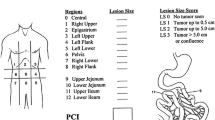Abstract
Purpose
The objective of this study was to identify features of preoperative computed tomography (CT) scans that can best predict outcomes of primary cytoreductive surgery in ovarian cancer patients.
Methods
Preoperative CT scans of 98 patients were evaluated retrospectively. Multiple logistic regression analysis was used to develop two models.
Results
Although optimal surgical reduction was attempted in 98 patients, 12 had suboptimal results. Having tumor implants on the small or large bowel mesenteries (any size) or at other sites (cutoff index: ≥1 cm) was found to be significant (p < 0.001) for predicting a suboptimal cytoreduction outcome. Two predictive models were created using multiple logistic regression analysis; both consider diffuse peritoneal thickening (DPT), infrarenal para-aortic or pelvic lymph node involvement, a bowel encasement tumor (≥2 cm), and any tumor implants in the cul-de-sac as significant. Model 1 adds consideration to any tumors in the pelvic or retroperitoneum and has an accuracy of 90.8% for predicting a suboptimal surgery. Model 2 (accuracy of 93.9%) adds to the core of predictors the presence of tumor implants on the bowel mesenteries (≥2 cm), omental caking (≥2 cm), and ascites fluid.
Conclusion
Using specific CT findings from patients with ovarian cancer, we have devised two predictive models that have an accuracy of greater than 90% for predicting whether cytoreductive surgery will completely remove all tumor tissue, which should greatly aid in the differential decision-making as to whether to attempt cytoreductive surgery first, or to advance directly to neoadjuvant chemotherapy.
Similar content being viewed by others
References
McGuire WP, Hoskins WJ, Brady MF et al (1996) Cyclophosphamide and cisplatin compared with paclitaxel and cisplatin in patients with stage III and stage IV ovarian cancer. N Engl J Med 334:1–6
Piccart MJ, Bertelsen K, James K et al (2000) Randomized intergroup trial of cisplatin-paclitaxel versus cisplatin-cyclophosphamide in women with advanced epithelial ovarian cancer: three-year results. J Natl Cancer Inst 92:699–708
Bristow RE, Tomacruz RS, Armstrong DK, Trimble EL, Montz FJ (2002) Survival effect of maximal cytoreductive surgery for advanced ovarian carcinoma during the platinum era: a meta-analysis. J Clin Oncol 20:1248–1259
Hou JY, Kelly MG, Yu H, McAlpine JN, Azodi M, Rutherford TJ, Schwartz PE (2007) Neoadjuvant chemotherapy lessens surgical morbidity in advanced ovarian cancer and leads to improved survival in stage IV disease. Gynecol Oncol 105:211–217
Vergote I, Trope CG, Amant F et al (2010) Neoadjuvant chemotherapy or primary surgery in stage IIIC or IV ovarian cancer. N Engl J Med 363:943–953
Dauplat J, Le Bouedec G, Pomel C, Scherer C (2000) Cytoreductive surgery for advanced stages of ovarian cancer. Semin Surg Oncol 19:42–48
Onda T, Kobayashi H, Nakanishi T et al (2009) Feasibility study of neoadjuvant chemotherapy followed by interval debulking surgery for stage III/IV ovarian, tubal, and peritoneal cancers: Japan Clinical Oncology Group Study JCOG0206. Gynecol Oncol 113:57–62
Nelson BE, Rosenfield AT, Schwartz PE (1993) Preoperative abdominopelvic computed tomographic prediction of optimal cytoreduction in epithelial ovarian carcinoma. J Clin Oncol 11:166–172
Dowdy SC, Mullany SA, Brandt KR, Huppert BJ, Cliby WA (2004) The utility of computed tomography scans in predicting suboptimal cytoreductive surgery in women with advanced ovarian carcinoma. Cancer 101:346–352
Axtell AE, Lee MH, Bristow RE et al (2007) Multi-institutional reciprocal validation study of computed tomography predictors of suboptimal primary cytoreduction in patients with advanced ovarian cancer. J Clin Oncol 25:384–389
Everett EN, Heuser CC, Pastore LM, Anderson WA, Rice LW, Irvin WP, Taylor PT (2005) Predictors of suboptimal surgical cytoreduction in women treated with initial cytoreductive surgery for advanced stage epithelial ovarian cancer. Am J Obstet Gynecol 193:568–574 discussion 574–566
Bristow RE, Duska LR, Lambrou NC, Fishman EK, O’Neill MJ, Trimble EL, Montz FJ (2000) A model for predicting surgical outcome in patients with advanced ovarian carcinoma using computed tomography. Cancer 89:1532–1540
Gemer O, Gdalevich M, Ravid M et al (2009) A multicenter validation of computerized tomography models as predictors of non-optimal primary cytoreduction of advanced epithelial ovarian cancer. Eur J Surg Oncol 35:1109–1112
Bland AE, Everett EN, Pastore LM, Andersen WA, Taylor PT Jr (2008) Predictors of suboptimal surgical cytoreduction in women with advanced epithelial ovarian cancer treated with initial chemotherapy. Int J Gynecol Cancer 18:629–636
Ferrandina G, Sallustio G, Fagotti A et al (2009) Role of CT scan-based and clinical evaluation in the preoperative prediction of optimal cytoreduction in advanced ovarian cancer: a prospective trial. Br J Cancer 101:1066–1073
Chi DS, Venkatraman ES, Masson V, Hoskins WJ (2000) The ability of preoperative serum CA-125 to predict optimal primary tumor cytoreduction in stage III epithelial ovarian carcinoma. Gynecol Oncol 77:227–231
Memarzadeh S, Lee SB, Berek JS, Farias-Eisner R (2003) CA125 levels are a weak predictor of optimal cytoreductive surgery in patients with advanced epithelial ovarian cancer. Int J Gynecol Cancer 13:120–124
Salani R, Axtell A, Gerardi M, Holschneider C, Bristow RE (2008) Limited utility of conventional criteria for predicting unresectable disease in patients with advanced stage epithelial ovarian cancer. Gynecol Oncol 108:271–275
Armstrong DK, Bundy B, Wenzel L et al (2006) Intraperitoneal cisplatin and paclitaxel in ovarian cancer. N Engl J Med 354:34–43
Classe JM, Muller M, Frenel JS, Berton Rigaud D, Ferron G, Jaffre I, Gladieff L (2010) Intraperitoneal chemotherapy in the treatment of advanced ovarian cancer. J Gynecol Obstet Biol Reprod Paris 39:183–190
Acknowledgments
The authors would like to thank G. S. Buzard for his constructive critiques and editing of our manuscript.
Conflict of interest
The authors declare no potential conflicts of interest.
Author information
Authors and Affiliations
Corresponding author
Rights and permissions
About this article
Cite this article
Fujwara, K., Yoshino, K., Enomoto, T. et al. Usefulness of computed tomography in predicting cytoreductive surgical outcomes for ovarian cancer. Arch Gynecol Obstet 284, 1501–1507 (2011). https://doi.org/10.1007/s00404-011-1864-3
Received:
Accepted:
Published:
Issue Date:
DOI: https://doi.org/10.1007/s00404-011-1864-3




